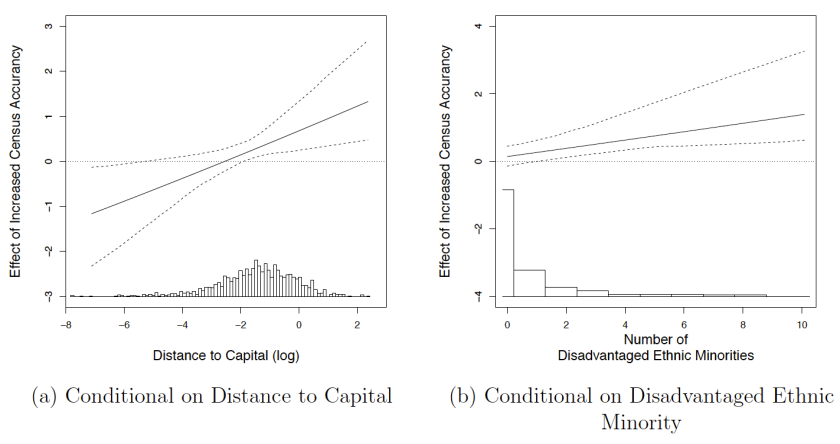By Luwei Ying, Ph.D. Candidate, Department of Political Science, Washington University in St. Louis

Political scientists and policy-makers have long argued that state weakness leads to civil conflict while enhancing state power helps prevent violence. Why, then, has increased state capacity worldwide coincided with more civil conflicts? This paper offers one potential explanation by disentangling the relationship between state power projection and civil conflict at the sub-national level. While most previous literature studies state capacity at the country level, state presence — also termed as state penetration or state reach — is in essence a spatial phenomenon. States do not govern each local area equally well at any given time (e.g., Lee, 2018). I argue that the overall increasing state capacity enables and incentivizes the state to govern the previously ungoverned or poorly governed regions. Such enhanced state presence often provokes the local non-state powers and can trigger civil conflict. The effect is particularly likely in peripheral regions where residents are concentrated disadvantaged ethnic groups. This unintended consequence of state presence may account for the higher levels of violence taking place in these regions.
These arguments speak to a larger debate on the global trend of armed conflict and the role that state capacity plays in it (Gohdes and Price, 2013; Lacina and Gleditsch, 2013; Pinker, 2011; Sarkees, Wayman and Singer, 2003; Scott, 2010). Noticing that ungoverned spaces have started to disappear as state capacity grows after World War II, Scott (2010) sends a caveat that clashes may occur between the peasant communities and the intrusive state. While optimist views represented by Pinker (2011) suggest that increasing state capacity decreases violence over time, the current paper indicates that extending state presence has indeed come with a backlash.
I conduct two sets of analyses to demonstrate the proposed effect of state presence. The first analysis is at the first-level administrative units, e.g., provinces. Following Lee and Zhang (2016), I use the accuracy of census data as a proxy for state presence, which covers seventy-four countries across twenty-five years. The periodic nature of census allows me to calculate the change of state presence over time. The civil conflicts concerned here are those that fall within each province in the years subsequent to the census. I find that a large rise in state presence increases civil conflicts in succeeding years. This violence-inducing effect is moderated by two conditions: distance to the capital and the presence of geographically concentrated ethnic minorities. State presence is more likely to trigger violence in distant regions and in those with different disadvantaged ethnic identities. This pattern, as depicted by Figure 1, is consistent with the theory relying on the resistance from non-state actors because the two moderators often favor the formation of a local authority prior to the state’s arrival.
 Caption: Marginal Effects of Enhanced State Presence Using Kernel Estimators
Caption: Marginal Effects of Enhanced State Presence Using Kernel Estimators
Note: The 95% confidence intervals are shown. They are obtained from a non-parametric bootstrap procedure clustering on countries.
The second analysis is at the ethnic group level. I collect global ground transportation data (road and railroad) and overlay it with the settlement patterns of politically relevant ethnic groups using Geographical Information System (GIS). Figure 2 shows an example with Nigeria. This constitutes a measure of state presence in relation to individual ethnic groups. Multiple data sources identify the conflict incidents for which each ethnic group claims responsibility. Results further show that, among ethnic groups not fully incorporated into the state systems, those reached by the state are more likely to revolt than their isolated counterparts.
 Caption: Measuring State Presence Engaged with the Ethnic Tiv (Nigeria) using Transportation Connection
Caption: Measuring State Presence Engaged with the Ethnic Tiv (Nigeria) using Transportation Connection
Note: The connection points counted here are those that connecting the Tiv to the other parts of Nigeria (eventually to the capital, Abuja, through the transportation network) but not to other neighboring countries.
This study provides insights into understanding the puzzling and complex relationships between state capacity and civil conflict. The sub-national level analyses challenge the conventional wisdom that extending statehood reduces violent incidents (Pinker, 2011) and show that it could have the opposite effect. The paper thus deepens our understanding of the state’s role in civil conflicts. It implies that state building practice should put more weight on negotiations with established local non-state authorities to prevent fierce resistance. However, Scott (2010)’s argument that groups in peripheral areas often settled there to escape the state’s reach suggests this will be hard.

About the Author: Luwei Ying, Ph.D. Candidate, Department of Political Science, Washington University in St. Louis, Campus Box 1063, One Brookings Drive, St. Louis, MO 63130; luwei.ying@wustl.edu.
References
Gohdes, Anita and Megan Price. 2013. “First Things First: Assessing Data Quality before Model Quality.” The Journal of Conflict Resolution 57(6):1090-1108.
Lacina, Bethany and Nils Petter Gleditsch. 2013. “The Waning of War Is Real: A Response to Gohdes and Price.” Journal of Conflict Resolution 57(6):1109-1127.
Lee, Melissa M. 2018. “The International Politics of Incomplete Sovereignty: How Hostile Neighbors Weaken the State.” International Organization 72(2):283-315.
Lee, Melissa M. and Nan Zhang. 2016. “Legibility and the Informational Foundations of State Capacity.” The Journal of Politics 79(1):118-132.
Pinker, Steven. 2011. The Better Angels of Our Nature: Why Violence Has Declined. New York, NY: Viking.
Sarkees, Meredith Reid, Frank Whelon Wayman and J. David Singer. 2003. “Inter-State, Intra-State, and Extra-State Wars: A Comprehensive Look at Their Distribution over Time, 1816-1997.” International Studies Quarterly 47(1):49-70.
Scott, James C. 2010. The Art of Not Being Governed: An Anarchist History of Upland Southeast Asia. New Haven, CT: Yale University Press.
